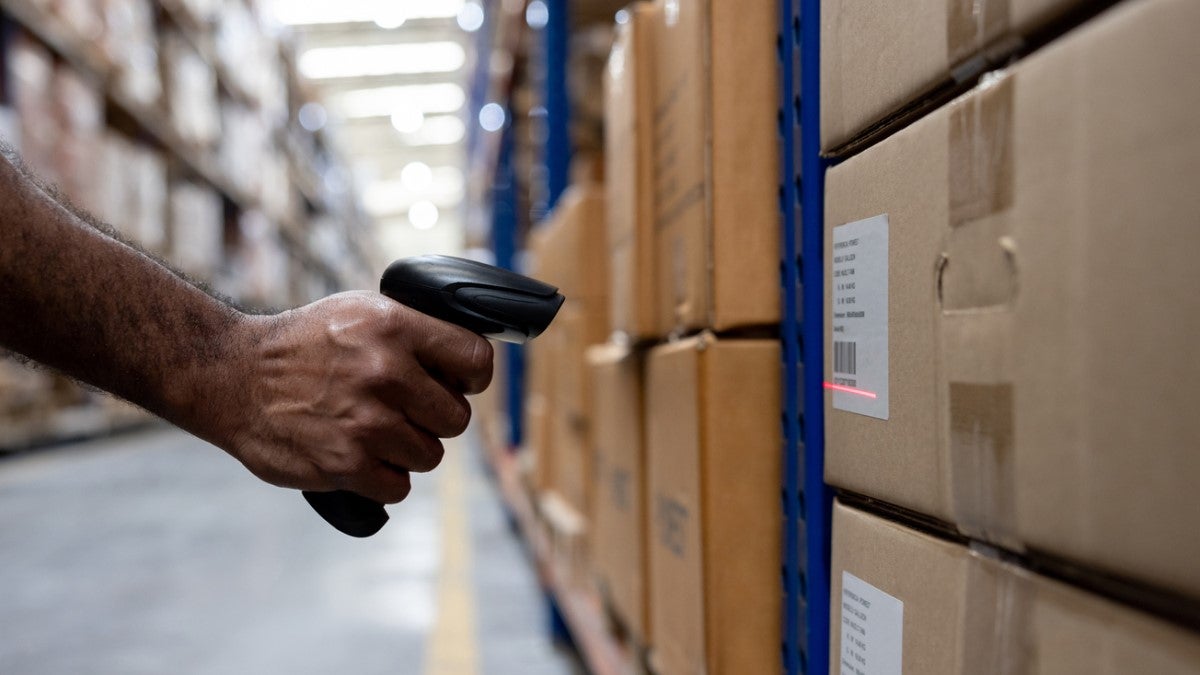How can exporting meet the evolving needs of business leaders?
Small- and medium-sized businesses that sell into overseas markets could build the resilience to withstand tough economic headwinds and generate growth. But to do so requires a shift in mindset, education and a data-driven strategy

Business founder and CEO Julianne Ponon started her exporting journey without a roadmap. “We didn’t really know what we were doing,” she admits. She bought Creative Nature in 2012 despite the company posting losses of £56,000 and set about transforming the brand into a healthy eating and superfood giant. UK success was quickly followed by interest from retailers overseas. “I had so many questions. Do we need a distributor? Do we need an agent? What are the paperwork requirements? How much will it cost?”
Her business now exports to 18 countries across multiple continents and is responsible for around 15% of the company’s revenue. “We want it to be around 25%,” she adds. It’s a success story the UK government is keen for other small- and medium-sized businesses to replicate to boost the economy amid a challenging retail landscape. In 2023, 62 stores closed across the UK as a result of retail businesses failing. That’s the highest number since the Centre for Retail Research began collecting this data in 2007.
Brexit, the Covid-19 pandemic, soaring energy bills, the cost-of-living crisis and supply chain disruptions caused by the Russia-Ukraine war and Israel-Hamas conflict have eaten into the margins and profitability of SMEs. But exporting could provide an opportunity to boost growth and resilience, by reducing their dependence on a struggling domestic market. Businesses that export could also leverage higher production volumes at more affordable prices and gain new market insights that fuel product innovation. Both could yield a competitive advantage.
Despite that potential upside, less than 10% of UK SMEs currently export, compared to 44% in Germany. “Many view exporting as risky; it’s a resource-intensive activity and SMEs don’t have an abundance of resources, in terms of cash, time, personnel or knowledge to implement an effective and compliant export strategy,“ says Fragkiskos Filippaios, a professor of international business at Essex University. “Exporting also requires a change in mindset. SMEs often see exporting as a distraction from running their business, rather than an opportunity.”
But even those with the right mindset often lack the knowledge to create and execute an exporting strategy. Ponon enrolled on the UK Trade and Investment department’s former ‘Passport to Export’ programme to gain the knowledge and confidence she needed to sell overseas. Now, she’s part of the government’s Small Business Council, which brings together a selection of SME leaders from across the country, with the aim of helping SMEs to grow. The council has launched a ‘Help to Grow’ campaign to provide a hub of support and advice for small firms, with an emphasis on building international sales.
Ponon says an important first step is establishing a target market. “You need to look at the USP of your products and think about which countries may benefit from them,” she says. “I’d contact the Department for Business and Trade (DBT) or the Federation of Small Businesses (FSB) and get some market data. You can also get data for free from the British Library.”
Ponon and her team at Creative Nature used this approach when exploring Middle Eastern markets. They conducted research into the ratio of people suffering from an allergy in the region (all of their products are free from the top 14 allergens) and found a new market of potential customers.
PR is another effective and affordable tool for SMEs to assess potential interest in a product or service. “Your PR strategy needs to be adapted by region, taking into account market maturity and local cultural intricacies,” says Heather Delaney, the founder of Gallium Ventures, a PR and communications consultancy for technology brands. “We also help SMEs to use PR and media coverage to generate conversations with potential partners, such as resellers and distributors or other brands they can connect with.”
Meticulous research can also provide valuable cultural insights into potential new markets. “In the Middle East, businesses require health certificates to export foods and in Dubai, SMEs need to be signed off by the municipality so that they have accreditation to sell into the market.” SMEs should always check the rules for food and other goods that might need certificates or have restrictions, as regulations are not the same in every country.
Filippaios says businesses should approach their exporting journey with common sense. “I would start by exploring markets that look and feel relatively similar to your home market, where you have an understanding of how consumers work from a cultural point of view, and you’re familiar with the legal requirements of that country,” he says. Security is another consideration for leaders. “I work with a B2B technology firm in Kent that has internationalised in China. It needed to safeguard its products so that nobody could copy what they do, so they needed to consider IP protection before exporting.”
If education, market and product fit are aligned, SMEs are well-positioned to begin their exporting journey. “My advice to SMEs is to consider exporting from day one and build that into your business strategy,” says Ponon. “If I were starting a new business today, that’s exactly what I’d do.” SMEs that are successful in selling overseas could reap lucrative long-term benefits. “Diversifying markets allows brands to reach a larger audience and new partners – which could even help to secure a lucrative exit,” says Delaney.
With another difficult 12 months ahead, exporting could be the boon SMEs need to survive and thrive.
Delivered on time: getting exports right
To export successfully, SMEs must choose their target markets with precision, gain an understanding of their cultural and legislative intricacies, and find the right partners to help them navigate borders and deliver goods to their customers with efficiency

It started as a side hustle. Summer Obaid and her husband and business partner, Omar, began selling his artwork nine years ago. Today, their 10-person-strong business, Abstract House, has become the UK’s most loved sustainable art gallery. The company designs, manufactures and ships original art and frames to customers in 70 countries worldwide and boasts a trade client list that includes TikTok, Netflix and Aviva.
Their international success didn’t happen overnight. Shortly after launching the business in 2017, website data revealed interest from overseas, but exporting proved a challenge. “Shipping was incredibly complicated,” says Summer Obaid. “Every way we tried to ship, the items kept being shipped back to us. There was a period when we had to halt exporting completely because it was costing us money and reputational damage.”
It’s an experience that’s common for small- and medium-sized businesses at the beginning of their exporting journeys. But it can be avoided with the right insights, partners and planning.
A 2023 survey of 2,300 SME exports by the British Chambers of Commerce cited three main cost pressures for UK SME exporters: energy (72%), labour (67%) and raw materials (61%). UK Export Finance (UKEF) is the UK’s export credit agency and helps SMEs to fulfil orders if cash flow is an issue. It partners with banks including Lloyds, Barclays, NatWest and Santander to provide bank guarantee schemes. This guarantees the bank’s non-payment risk from that exporter when it provides them with business loans.
Amy Clarke, UKEF’s head of short-term business, says: “The banks come to us with their customers and say: ‘This is an SME, they want to increase their export levels or start exporting, and we’d like to help them. But we’re not willing to take all of the credit risk. We’ll take X amount if you can guarantee up to 80% of it.’ We then speak to the SME and see if they meet our criteria. For example, have they exported before? Do they have a good credit rating? You can be a first-time exporter, too, but most SMEs we deal with have some experience.”
Despite other potential challenges such as tariffs, quotas, and regulations, SMEs can successfully navigate trade barriers with the right delivery partner and support. Expert insight can make these obstacles manageable, leading to growth and making export ventures more efficient and attractive to both the business and consumers.
Mike Wilson, the founder of exporting consultancy, Go Exporting, is a man many turn to. “We have a scoring system where you can compare one country to another, taking into account market size and potential growth as well as barriers to entry and the rules and regulations to get in there,” he says. “You also need to assess the level of competition and how difficult it is to transport your goods to and through that country.” Wilson has a network of consultants in 40 countries to build an accurate picture of the challenge and create a league table. This ensures SMEs focus their resources on the right markets.
Complying with border controls is another necessity for SMEs seeking to export. In 2021, Chris Salmon, a former senior policy advisor with the Cabinet Office, founded international trade consultancy clearBorder. Customs declaration forms are a common issue. “These are official documents that detail the goods being exported, such as rules of origin,” he says. “You need to accurately state the natural source of the goods as this determines the duties applied. Just because your goods are shipped from the UK doesn’t mean they originated there. If the details are wrong, a surcharge could be added or the products returned, which could result in a really poor and costly customer experience.” While this may sound like a potential headache, there is plenty of guidance and support available to help SMEs navigate customs.
SMEs that want to export to the EU are now likely to pay VAT on goods shipped to a member state, and this can provide another headache if responsibility for the bill isn’t clarified between all exporting parties in advance. “You need to be clear on who’s paying it,” adds Salmon. “If you’re selling directly to a consumer, you don’t want parcels arriving on someone’s doorstep with a VAT bill. It needs to be delivered with everything prepaid, which means that you as a seller or one of your agents has to be covering things like that and duties.” Again, preparation is key here – SMEs with the right support and partners are well-positioned for success. While successful exporting comes with a bit of homework, the payoff can be great.
After halting its exporting operations all those years ago, Abstract House has begun exporting overseas again with trusted partners. Now, they have a new international market in their sights. “We have European channels, but we think there’s a massive market in Scandinavia,” says Obaid. With the right strategy and partners by their side, it’s one they seem certain to conquer.
Exporting matters: challenges and opportunities in international business growth
What are key business challenges preventing exporting? How can British companies take advantage of the opportunities available? Where do the opportunities lie?
Going the extra mile: how to find the right logistics partner
Many small- and medium-sized businesses in the UK perceive exporting to be complex and costly. But the right logistics partner can provide SMEs with the tools, infrastructure and confidence to deliver goods overseas and build global businesses

For the majority of the UK’s 5.5 million small- and medium-sized businesses (SMEs), their exporting journey ends long before it begins. “Every day, we speak to businesses that are considering exporting and their initial perception is that it’s going to be too complex to navigate,” says Michael Irwin, Royal Mail’s director of export account.
For many, the obstacles outweigh the opportunities. The Department for Business and Trade’s National Survey of Registered Businesses’ Exporting Behaviours, Attitudes and Needs highlighted administrative costs, burdens and regulations abroad as significant barriers to entry for 26% of businesses surveyed.
In the aftermath of Brexit, when the UK left the single market and businesses were forced to comply with a slew of new regulations and paperwork in order to export to Europe, Royal Mail decided to act. “Brexit put a lot of SMEs off exporting to Europe and, by extension, exporting anywhere else,” says Irwin. “We made it our mission to show SMEs that exporting is different post-Brexit, but with the right guidance it isn’t that difficult.”
Royal Mail’s small business hub has become a trusted source of education for thousands of SMEs. It supports them with tools and resources for different stages of their exporting journeys; from businesses with no experience to those looking to increase export volumes or streamline their global operations. Its partnership with the Department for International Trade and its Exporting is Great campaign also aims to help SMEs compare markets, create an export action plan and access free government training. Businesses can also find more information about shipping overseas on Royal Mail’s dedicated international delivery page.
One of the common challenges SMEs face is complying with the exporting regulations of new markets and ensuring they communicate the necessary information. Failure to do so can result in hefty fines and penalties. “Data is the essential glue that fuels international ecommerce,” says Irwin. “If you can get a few simple things right: describing your goods in the right way, capturing how much they’re worth, where they’re going and the contact details of the end recipient, there’s no reason why you can’t start exporting overseas.”
Resilient supply chains are another critical component to exporting success, but last-mile delivery is fraught with challenges. In addition to data compliance, rising shipping costs and increasing expectations for businesses to deliver a seamless service mean SMEs must find the right logistics partner to ensure customers enjoy a speedy and efficient delivery service.
“The challenge for exporters is to mirror their domestic delivery,” says Irwin. They need to make the delivery experience for an item bought on a British website almost identical to the one the customer would enjoy had they bought this on a site in their home country.”
Experience and human relationships are key to creating a premium delivery experience. As the UK’s national postal operator, Royal Mail has developed long-standing relationships with 200 of the biggest and most trusted overseas postal networks, as well as airline and shipping operators, with the aim of replicating a Royal Mail delivery in the UK, overseas. “We have relationships with the likes of La Poste in France and Deutsche Post in Germany,” says Irwin. “What this means in practice is that we can recreate the familiarity of your postman or postwoman delivering your parcel in the UK to a customer overseas by using those connections.”
Transparency and tracking is another key consideration for SMEs. Royal Mail’s International Business Tracked service empowers businesses to track their exports at every step of the exporting journey and includes free returns for undelivered items. On some journeys, goods are tracked up to seven times en route to their final destination. In the rare event that a problem occurs during delivery processes are in place to ensure, issues can be investigated and resolved at speed. “We’ve got incredibly strong senior-level director-to-director relationships with postal carriers in Europe, the US and all over the world,” says Irwin. “This means we have been able to put processes in place that can help resolve issues quickly and get customers’ items moving again. This is because we’re doing the same thing for those operators when they export goods to the UK – those relationships are really valuable for exporters. They are just one of the many tools we use to support customers who export with us.”
For SMEs that have already begun their exporting journey, several international markets are becoming increasingly popular. “We’ve noticed a big increase in the volume of exports to India,” Irwin explains. “India is very much a growing market and the demand for British goods is increasing. “China and Japan are also getting bigger and we send a lot of goods to the US. We have an exceptionally good agreement with USPS, where we can give really good rates.” But for businesses taking their first steps in selling overseas, sometimes it’s wiser to start closer to home. “If you’re still unsure, I’d start with Ireland and the EU, because they’re closer and it’s not as hard to export there. From there, you can expand to different territories.”
Spice Kitchen: from retirement to international success
Spice Kitchen is a UK family-run spice company that ships direct to consumers all over the world. Now, it has its sights set on the US market. Sanjay Aggarwal, one half of Spice Kitchen’s mother and son duo, reveals the secrets behind their growing international success

Shashi Aggarwal was bored. Retirement had brought rest and relaxation, but she longed for a purpose to fill her days. The family’s 100-year-old spice grinder and her passion for cooking sparked an idea. She began making and selling traditional Indian spice boxes online and soon found an appetite for her creation amongst UK consumers.
It started as a hobby business, but Shashi and her son, Sanjay, saw an opportunity to build something bigger. Four years after the business was born in 2012, it began to attract interest from retailers. Today, their products are sold in several hundred retailers across the UK, including John Lewis, Selfridges and Wholefoods.
With the UK market conquered, international trade followed. “We were advised very early on to speak to the Department of Business and Trade (DBT) and to get an international trade advisor, which we did,” says Sanjay Aggarwal. “That was a great move for us and initially helped us to understand and navigate rules around Brexit as we looked to sell our products in Ireland.”
Trade missions have helped the Aggarwals to assess new markets and build an international business. “We’ve done 10 missions across Europe, the Middle East and the US over the last five or six years,” Aggarwal says. “It’s helped us to test our range and see which products appeal to different markets. We’ve met new retailers, learned about the practical challenges of exporting to different countries and built international sales.”
Investing time and money in overseas trips has also helped to identify markets that are unsuitable for the business as much as those that are potentially lucrative. The Middle East was initially seen as a potential goldmine for the brand, but after multiple visits to the Middle East, Aggarwal felt otherwise. “I left feeling it was one of the least important markets for us,” he says. “The market is already saturated with spices and our products would be lost.”
But there is another market that could prove to be transformational for Spice Kitchen. “Last year, we published our first cookbook,” Aggarwal says. “It sold well in the UK, but it did even better in the US. We then went out to Las Vegas in January and we realised that we probably should’ve focused on that market much sooner. The US is by far the biggest market for our products. We’ve now hired someone in California to help us with market research.”
Lessons have also come from peers. “We’ve built a really great network of food and drinks brands who are also expanding in the US,” he says. “There’s a lot of goodwill in our industry and people are happy to share their own experiences.” Sanjay is now returning the favour as a UK government-appointed DBT Export Champion, a role that sees him share his experiences with other SMEs aspiring to trade overseas.
One of the key insights he passes on to SMEs is the value of education. “I’d engage the DBT as early as possible,” he says. “They can help you to speak to an International Trade Advisor and also introduce you to their Export Academy, which will give you all the basics. From there, it’s about research: the size of your potential market, your competitors and pricing. Your best first market may be somewhere like Ireland because it’s cheaper to ship.”
He also stresses the importance of a reliable logistics partner: “You can have a great product but you need to make sure it gets to the right people.” As Spice Kitchen continues to expand, the focus on exports remains a crucial part of the Aggarwals’ strategy, promising even greater growth in the future.

